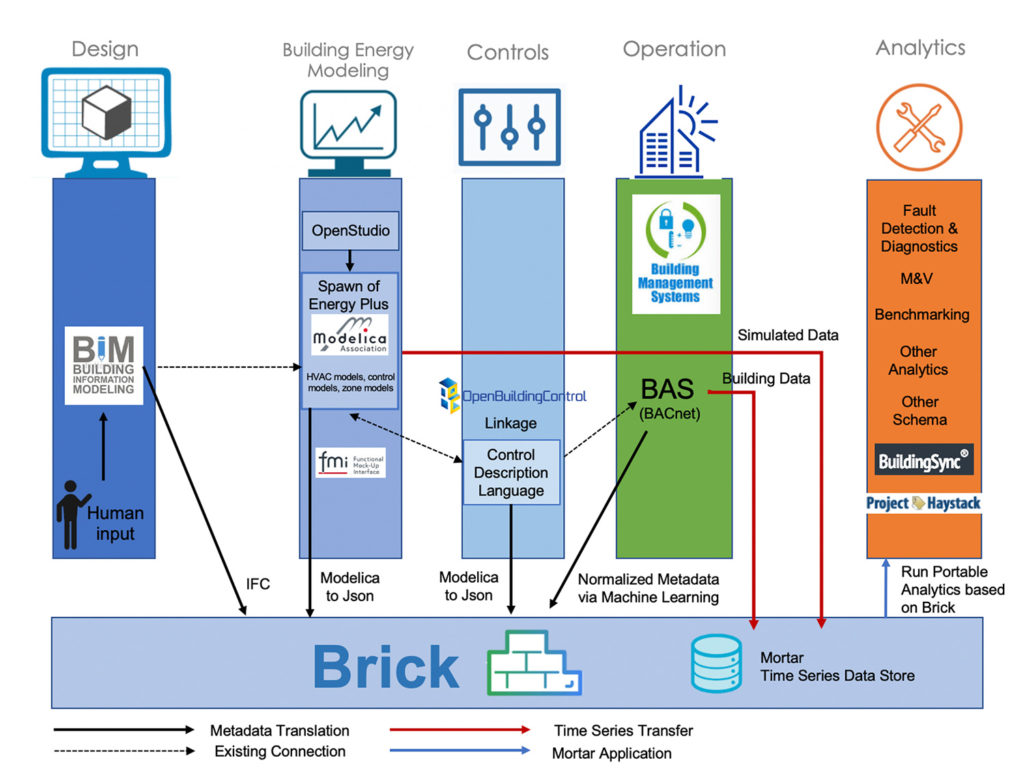Skewering the Silos: Advancing the open-source data model Brick into a demonstrated and tested tool
Status: Current
Funding Sources: US Department of Energy CBE Industry Consortium In-kind support from Johnson Controls
Project Objective
The goal of this project is to develop a nascent open-source common data model, Brick, into a robust tool that can enable the scaling of major energy savings, improved building performance, and grid responsiveness across commercial buildings through the implementation of advanced algorithms and analysis.
Significance to Industry
Implementing analytics and controls in existing commercial buildings can cost-effectively reduce energy use as well as improve building performance, and respond to electric grid demand for improved reliability and efficiency. However, currently available tools are difficult and expensive to incorporate in real buildings, due to controls vendors’ unique and irregular naming conventions and classification schemes, as well as the inherent uniqueness of commercial buildings.
In addition, the full potential of building cyber-physical tools, used throughout the design, construction and operation building lifecycle, is currently stymied by lack of integration. A common naming structure and organization, or schema, could provide the means to interoperate among these tools, such as building information models (BIM) 3-D mapping, advanced controls and analytics, and HVAC and building energy modeling (such as Spawn of EnergyPlus). Such a schema could also potentially coordinate across multiple building systems (e.g., sensors, HVAC, lighting) and provide dynamic and real-time control, and demonstrate values other than energy such as asset tracking.
Initiated by a consortium of universities and industry, Brick is an open-source schema for representing metadata in buildings. While Brick has been gaining traction recently, it has not been used at scale outside of small ad-hoc applications, and adoptions suffers from the lack of tools, translators, and integration with existing time-series databases for data analysis and building management
Research Approach
The specific tasks of the project are to: (1) expand the Brick schema, (2) develop tools and translators for adding information to Brick models, (3) develop an open-source building analytics platform that provides for tracking changes in the building (e.g., ‘version’ control of Brick models), (4) evaluate open-source building analytics and controls applications (e.g. ASHRAE Guideline 36, OBC) on several buildings, and (5) develop a technology transition plan.

To advance adoption, the team is working with the ASHRAE BACnet committee and Project Haystack to incorporate Brick as part of ASHRAE Standard 223P, a new proposed standard for semantic tagging of building data. UC Berkeley team members include Therese Peffer, Gabe Fierro, Paul Raftery and Carlos Duarte, along with researchers from LBNL and Johnson Controls. This project was funded as part of DOE’s Building Energy Efficiency Frontiers & Innovation Technologies (BENEFIT) program.
Publications and Reports
Peffer, T.; Fierro, G.; Raftery, P.; Roa, C. D; Pritoni, M.; Wetter, M., et al. 2023. Skewering the silos: using Brick to enable portable analytics, modeling and controls in buildings. UC Berkeley: Center for the Built Environment. https://escholarship.org/uc/item/04w0b9n2
Duarte Roa, C.; Raftery, P.; Sun, R.; Paul, L.; Prakash, A.; Pritoni, M., et al. 2022. Towards a stronger foundation: Digitizing commercial buildings with Brick to enable portable advanced applications. UC Berkeley. https://escholarship.org/uc/item/0dj216nq
Roa, C. D, Raftery, P., Prakash, A., & Peffer, T., 2023. Field demonstration of the Brick ontology to scale up the deployment of ASHRAE Guideline 36 control sequences. UC Berkeley: Center for the Built Environment. https://escholarship.org/uc/item/5zt2d66r
Sun, R.J., C. Duarte Roa, P. Raftery, and G. Fierro. 2022. Enabling portable and reproducible long-term thermal comfort evaluation with brick schema and mortar testbed. ASHRAE 2022 Annual Conference. https://escholarship.org/uc/item/5640w8m0
Bergmann, H., C. Mosiman, A. Saha, S. Haile, W. Livingood, S. Bushby, G. Fierro, J. Bender, M. Poplawski, J. Granderson, and M. Pritoni. 2020. Semantic interoperability to enable smart, grid-interactive efficient buildings. 2020 ACEEE Summer Study on Energy Efficiency in Buildings. August. https://people.eecs.berkeley.edu/~gtfierro/papers/semantic_interop.pdf
Fierro, G., M. Pritoni, M. AbdelBaky, P. Raftery, T. Peffer, G. Thomson, and D. Culler. 2020. Mortar: An open testbed for portable building analytics (journal extension). ACM Transactions on Sensor Networks. January. https://doi.org/10.1145/3366375 https://people.eecs.berkeley.edu/~gtfierro/papers/mortar_tosn.pdf
Fierro, G., J. Koh, Y. Agarwal, R. Gupta, and D. Culler. 2019. Beyond a house of sticks: Formalizing metadata tags with brick. 6th ACM International Conference on Systems for Energy-Efficient Buildings, Cities, and Transportation. November. https://doi.org/10.1145/3360322.3360862 https://people.eecs.berkeley.edu/~gtfierro/papers/HouseOfSticks-BuildSys-2019-Fierro.pdf
Fierro, G., M. Pritoni, M. AbdelBaky, P. Raftery, T. Peffer, G. Thomson, and D. Culler. 2018. Mortar: An Open testbed for portable building analytics. 5th ACM International Conference on Systems for Energy-Efficient Built Environments. November. https://doi.org/10.1145/3276774.3276796 https://people.eecs.berkeley.edu/~gtfierro/papers/mortar.pdf
Balaji, B., A. Bhattacharya, G. Fierro, J. Gao, J. Gluck, D. Hong, A. Johansen, J. Koh, Y. Agarwal, M. Berges, D. Culler, R. Gupta, M. Baun Kjaergaard, J. Ploennigs, and K. Whitehouse. 2016. Brick: Towards a unified metadata schema for buildings. 3rd ACM International Conference on Systems for Energy-Efficient Built Environments. November. https://doi.org/10.1145/2993422.2993577 https://people.eecs.berkeley.edu/~gtfierro/papers/brick.pdf

